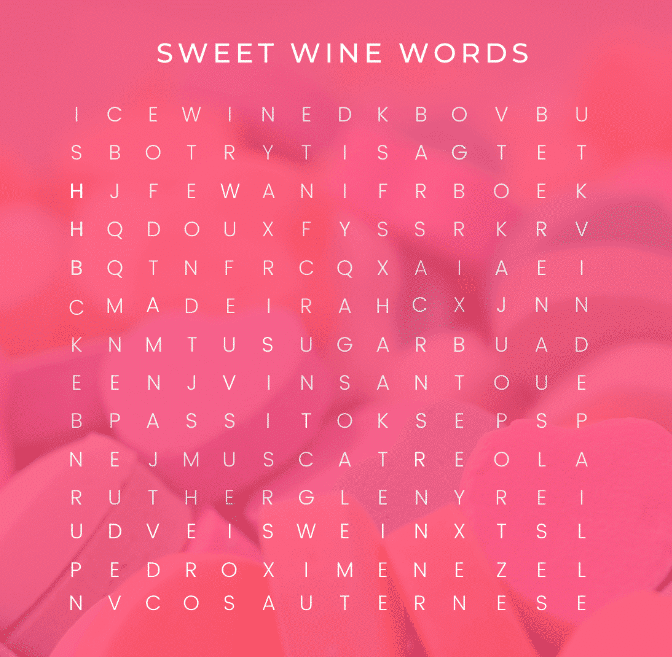Sweet Wines - Puzzle
Wine Wordsearch

Can you find all of the words? Click here to reveal the answers.
Fact Sheet - Sweet Wines of the World
Fact Sheet – Sweet Wines of the World
Introduction Sweet wines hold a special place in the world of viticulture, enchanting connoisseurs and casual drinkers alike with their rich flavors and aromatic complexity. This article delves into the diverse realm of sweet wines, celebrating their uniqueness and exploring their cultural significance across the globe.
The Sweetness in Wine: Understanding the Basics What transforms a regular wine into a sweet delight? The answer lies in the sugar content, which can originate from natural grape sugars or added sweeteners. Sweetness in wine varies from semi-sweet to lusciously sweet, each type offering a different sensory experience.
Europe’s Sweet Wine Gems France – Sauternes and Beyond France is renowned for Sauternes, a golden nectar born from noble rot grapes. But the French sweet wine repertoire extends beyond this, with regions like Alsace and Loire Valley contributing their own exquisite varieties.
Riesling Wines from Germany Germany’s Riesling wines, ranging from lightly sweet to intensely sugary, are celebrated for their balance of sweetness and acidity, making them highly sought-after among sweet wine aficionados.
Italy’s Asti and Moscato Italian sweet wines like Asti and Moscato d’Asti, sparkling with a gentle sweetness, are perfect for those who prefer a lighter, fruitier dessert wine.
Sweet Wines from the New World Ice Wines from Canada Canada’s ice wines, made from grapes frozen on the vine, are a testament to the innovation and resilience of New World wine production.
Late Harvest Wines of the USA The USA contributes with its late harvest wines, where grapes are left on the vine to concentrate their sugars, resulting in a rich, intense flavor profile.
Australia’s Luscious Dessert Wines Australia is not to be outdone, offering sumptuous dessert wines that are both bold and sophisticated, reflecting the country’s diverse climatic conditions.
Unique Sweet Wines Around the Globe Tokaji from Hungary Hungary’s Tokaji, a wine with a regal history, is cherished for its depth and complexity. Made from grapes affected by noble rot, it’s a true gem in the sweet wine world.
Portugal’s Port Wine Portugal’s contribution to the sweet wine spectrum is the globally revered Port, a fortified wine that boasts a rich history and a variety of styles.
Spain’s Sherry Spain’s Sherry, with its wide range of sweet to dry profiles, offers something for every palate. From the sun-soaked vineyards of Jerez, Sherry stands as a testament to Spain’s viticultural heritage.
Pairing Sweet Wines with Food Sweet wines are not just for desserts; they pair wonderfully with a variety of foods. From the classic combination of blue cheese and Sauternes to more adventurous pairings like spicy Asian cuisine, the possibilities are endless.
The Art of Producing Sweet Wine Producing sweet wine is an art form, involving specific techniques such as late harvesting, drying grapes, and using noble rot. The influence of climate and terroir is paramount in creating the unique profiles of these wines.
Sweet Wine in Cultural Traditions Sweet wines have a storied place in cultural traditions around the world, from being a symbol of luxury and celebration to their use in religious ceremonies. This rich history adds to the allure and appreciation of these wines.
Health Benefits and Risks Enjoyed in moderation, sweet wines can be part of a healthy lifestyle. However, it’s important to be mindful of their higher sugar content and caloric value.
Storing and Serving Sweet Wines Proper storage and serving can greatly enhance the enjoyment of sweet wines. Ideal conditions include a cool, stable temperature and the right glassware to fully appreciate their aromas and flavors.
Exploring Sweet Wine Tours and Tastings Visiting sweet wine regions and participating in tastings can be a delightful way to explore these wines’ diversity. Notable regions include the Sauternes in France, the Mosel Valley in Germany, and the Douro Valley in Portugal.
Sustainable Practices in Sweet Wine Production Many sweet wine producers are embracing sustainable practices, from organic viticulture to biodynamic methods, ensuring the longevity and health of their vineyards.
The Future of Sweet Wines Sweet wines continue to evolve, with trends like lower alcohol levels and innovative blending techniques. Their growing popularity is a testament to their enduring appeal.
How to Start Your Sweet Wine Journey For those new to sweet wines, start by trying different styles to discover your preferences. Understanding wine labels and vintages can also enhance your appreciation and selection process.
Conclusion Sweet wines offer a rich tapestry of flavors, histories, and experiences. Whether you’re a seasoned enthusiast or a curious newcomer, the world of sweet wines is waiting to be explored.
FAQs
What is the best temperature to serve sweet wine? Sweet wines are best served chilled, between 8-12°C (46-54°F), depending on the style.
Can sweet wine age well? Many sweet wines, like Sauternes and Tokaji, can age beautifully, developing complex flavors over time.
Are sweet wines only for dessert? No, sweet wines can be paired with a wide range of foods, including cheeses, spicy dishes, and even savory meals.
How long can I store an opened bottle of sweet wine? Once opened, sweet wines can last for several weeks if stored properly in the refrigerator with a wine stopper.
Are there any low-sugar sweet wines? Yes, some winemakers produce sweet wines with lower sugar content, offering a lighter option for those mindful of sugar intake.












